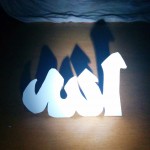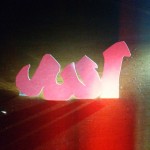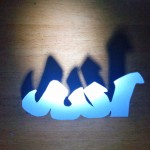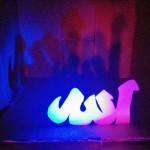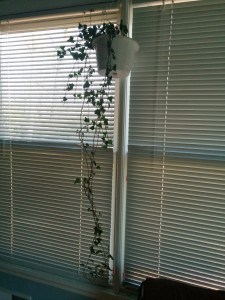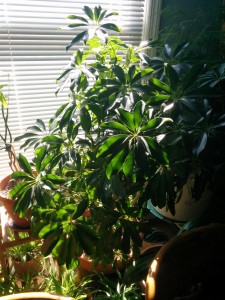Light of Allah: An Experiment in Illumination (Calligraphy Project)
March 18th, 2014
One of the asma al-husna, the ninety-nine beautiful names of God, says God is al-Nur, or the Light. God is a shining Light that illuminates the sirat al-mustaqim path of righteousness and leads the way, a Light that is radiating with jamal beauty and jalal majesty, a Light that shines hope into the darkness. In my project, I handle the concept of light and darkness literally.
I started with a cutout of a standard calligraphic representation of Allah. This representation was cut out of white paper to illustrate the purity of God as al-Mutahhir The Purifier and al-Mubayyin The Clarifier. However, shining various colors and angles of light challenged the purity of the white. Though the believers are cut from the same fabric as God and are intrinsically pure, they are often colored by their earthly experiences, making them forget their origins and their God.
Just as muslims submit to God, the project submitted to the varying angles and brilliances of the lights. Some of the more interesting pieces include the red light illuminating an long shadow and highlighting the middle of the calligraphy, creating a fiery effect. An interpretation of this image is the reference of the prophet as siraj munir, radiant Lamp or seeing Allah as a fire in the source of light, of passion. This coloring could be misinterpreted as devilish, demonstrating how an image can be seen in very different light by different people. Other interesting pieces include the ones in the box, where the light shining on the calligraphic representation result in reverberating shadows, as the name of Allah echoes as the believers profess their faith with the shahada. And the ones with a mix of colors in the box demonstrate how fairly diverse sentiments do not always have to clash, rather, can work together and coexist, as encouraged by God and the Prophet.
The project demonstrates the contrasts between the Light of God and the darkness that may pervade from sin, forgetfulness, earthly desires, despair. Ultimately, the Light shines and dispels the darkness, as God and the Prophet Muhammad bring the people from darkness to Light.
Light of Muhammad (Week 4)
March 18th, 2014
For week 4, we discussed the role of the Prophet Muhammad in the lives of those who believe. In our readings of “In Praise of Muhammad: Sindhi and Urdu Poems” and “Miracles of Muhammad”, we saw how Muhammad was revered as a lover, a bridegroom, and a friend.
First and foremost, the Prophet was a Messenger of God, having gone on a mystical night journey both in body and in spirit from Mecca to Jerusalem in the isra and ascending into heaven to speak with God in the miraj. From that point on, Muhammad was an intercessor between Man and God, exalted above the common, but not yet as Divine as the Creator. He relayed the Qur’an, the pure word of God as told to him by the Angel Gabriel, and even translations of that word were seen as mere interpretations. He was seen as the embodiment of the Qur’an, having his life recorded in stories known as the hadiths, that recounted his sayings and actions. These are often interpreted and through tafsir exegesis became the basis of Islamic sharia law. What he said was important, as sometimes he would speak in the first person as God in hadith qudsi, delivering the word of God. His actions were also important, creating a set of sunnah, or his customs, that would dictate the way in which Muslim live.
Another important aspect of the life of the Prophet was the Nur Muhammad or the light of Muhammad that presented itself not only in the means of connecting all of the Prophets with Divine light and spirit, but also as Muhammad shone light along the proper path for those who submitted to the Will of God. For this reason, Muhammad is often described and depicted as a Lamp both in the stories as well as the artworks. It is from this idea that I draw my inspiration.
The piece I have created using black paper and colored chalk showcases Muhammad as a lamp out of which is seen a flame, or the light of God. In the background there is the witnesses, the believers, whose eyes reflect the light of God as well as reflect the light of God within their own soul. This plays upon the idea that God is both around us as well as within us, and we are able to see him because of the guidance of Muhammad. The fact that there are only a few colors, shows that all is interconnected. The yellow of the lamp represents Muhammad, but there is also yellow in the orange fire, as both God and Muhammad shine forth. However, in it all, there are also hints of white, which show that humans are also a part of this Divine communication as well.
Improvisation on the Adhan (Week 3)
March 18th, 2014
During week 3 with the topic of Qur’an recitations, we talked a lot about the importance of the oral and aural experience of the Qur’an. I am very much moved by the aural experience as a musician myself. Since I myself do not know the Arabic or the tajwid/tartil described in the “External Rules of Qur’an Recitation” or featured in the documentary “Koran By Heart” necessary to properly recite the Qur’an, I decided to pick another important melodic theme from Islamic faith.
One of the important aspects of Muslim prayer is the adhan, the call to prayer. It has the purpose of both bringing people together to worship God as well as words that assert God’s greatness. The first part, the takbir shows that God is Greater than anything that can be imagined or conceived, beyond analysis. And the second part is from the shahadah, or the creed of faith, distinguishing those who are muslims, or submitters, from those who are Muslims, or followers of God.
As we saw in class, there are many different renditions of this call to prayer, depending on the context in which it is created, developing various “religious soundscapes.” This is similar to the variations in the style of the Qur’an recitation, as seen in the readings “The Qur’an in Indonesian Daily Life” and “The Sound of the Divine in Daily Life.” We heard examples from One of the performances that I really enjoyed is the one below:
I really like the calm it creates and it is so beautiful it almost gave me the chills! This inspired me to create my own interpretation of the adhan, based on my context of musical styles and abilities. A recording of the “Improvisation on the Adhan” that I played on my violin is linked below:
(If the above link does not work, you can access the recording at “http://blogs.law.harvard.edu/jming/files/2014/03/Improvisation-on-the-Adhan.m4a”).
I use the main theme from the adhan in the sense of following the theme that is created during the takbir and repeated it using different variations in octave, style, tempo, and dynamic. Then, I also include the change in the melody that is a result of the two lines, Hayya ‘ala ‘s-salah and Hayya ‘ala ‘l-falah. Finally, I end it again with the melody based on the line that praises Allahu akbar!.
The fact that I used music, however, brings up another concept that we discussed in class–the correctness of the representation of the Islamic faith using Music. There is still much debate around the use of Music as either an extension of worship or as sacrilegious. Through this Meditation of a piece, I hope to express my thoughts and have no intention of being offensive.
Arabesque (Week 6)
March 17th, 2014
One of the prominent features of Islamic art and architecture is the arabesque, or geometric ornament. An example of an arabesque is seen below:
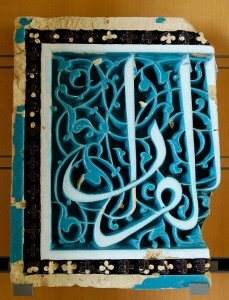
Scholars of Islamic art have come up with various interpretations of the arabesque, looking at its abstraction as a sign of infinite correspondence in mathematical sciences or its delicate appearance as a sign of femininity as detailed in “The Topaki Scroll” by Gulru Necipoglu. However, one of the more prominent interpretations of the arabesque pick up on its allusion to nature.
As described in the documentary “Islamic Art: Mirror of an Invisible World”, the arabesque can serve as a witness to God’s creation. God created the world as al-Muhyi, the Giver of Life to all the creatures (8:24). In all of creation, there is not only the face of God, but also the ayah or the signs of God are all around for the creatures to interpret (2:115, 2:164). Including images of nature in works of art is one way of not only celebrating and praising the beauty of God’s creation but also in becoming closer to God.
With all of this in mind, I found that there were also signs of nature and God’s creation in the plants around my house. Among the few that I saw, I picked out a few that I felt were the most geometric, resembling the orderly nature of God’s creation.
Then I represented each one with a different color in paper, layered on top of each other to create a vibrant arabesque that reflects my own surroundings of God’s creation, my own context, made with my own materials and skills, as common in a cultural-studies approach.
The reason I chose bright colors is because as described in the documentary “Islamic Art: Mirror of an Invisible World”, color is an important means of demonstrating meaning in Islamic art, and I happened to choose colors that would represent nature and life the most (green and yellow) as well as passion and fire (red). Additionally, I worked with the nature of the plants, using the linked nature of the cactus-leafed plant to set the sturdy structure of the piece demonstrating that faith is a constant around which all else is built, the symmetry of the many leafed plant to highlight brilliance akin to the sun to demonstrate that God is the Light, and the swirling stems of the ivy to demonstrate the turbulence and adventure each day will bring.
Though not nearly as intricate as a arabesque carved out of a block of wood (rather, from the pulp of wood that once was), the piece captures the spirit and the essence of this fundamental feature of Islamic art.

